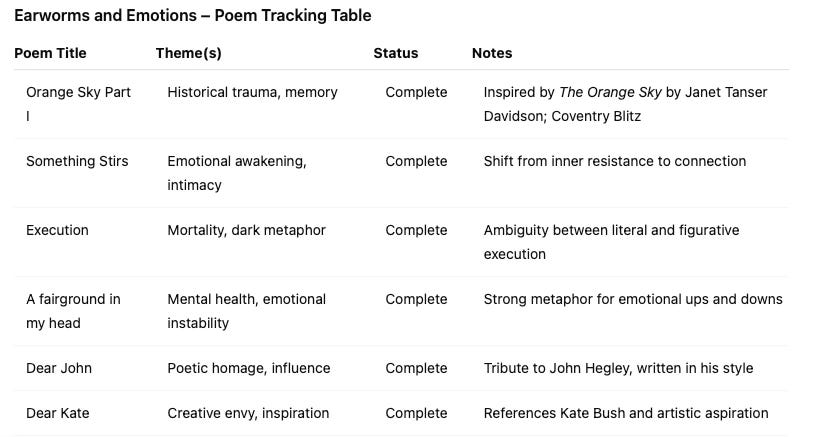Using AI in Creative Writing
General thoughts on the use of AI to support creative writing
It can’t have escaped your attention that AI is flavour of the month. Seemingly every other post or every other blog is AI related.
Now, I don’t want to be another one of those people ranting on about AI, but I do use AI as to support my writing, and it’s probably worth putting this on paper as it may be useful to others in the community.
So this post is an overview of my use of AI, specifically around my forthcoming book, “Earworms and Emotions”, and this SubStack, “The Ode Map”.
Boundaries
Like all new technologies, no matter how amazing they appear, it’s always good to (a) understand what they are doing, (b) understand the limitations of their abilities.
With that understanding, you are better equipped to use the technology safely, sensibly and with better effect.
So remember, AI doesn’t ‘think’, it just puts words together - one after the other - based on some internal links, weights and a vast amount of (mostly pirated) written material (most of which is either biased, out of date, or plain wrong).
With that in mind, here are my boundaries for AI use with creative writing:
Any time I am getting AI to create something, I assume it’s wrong or rubbish or both. I never publish anything created by AI as-is. I will never get AI to create a poem or blog post; I’ve tried it and the amount of work involved in editing the result is more than had I written the whole thing from scratch.
Any time I am getting AI to advise on something, I make sure it has all the context by way of uploaded documents, etc. that are relevant. I will ask questions in different ways to make sure any advice I receive is consistent. And I will, where possible, then check on the wider web for prior art or general consensus.
AI and The Ode Map
When I decided to re-launch my SubStack, I used AI to help me:
Write all the ‘boiler plate’ content (text for the the various emails, the 'about' page, etc.);
Decide on different content streams / themes;
Decide on a free/paid split and what to include in each;
Devise a blogging schedule.
You’ll note that point 1, above, the AI is a creator; for points 2 - 4, AI is an advisor.
Also, you’ll note that I said ‘help me’ - I went through a number of iterations and ‘conversations’ with AI for each of those activities before settling on what I wanted.
All the above is done in a ChatGTP project to keep it separate from my other uses of ChatGTP. This is to prevent bleed, and keep my Ode Map ‘style’ separate from my corporate ‘style’.
AI and ‘Earworms and Emotions’
I have a separate project in ChatGTP that 'knows about' the book I'm writing - I've provided information about the themes, etc. and uploaded my previously published works, so it has background on my work.
Each time I complete a poem I add it to the project, and get it critiqued. I do this purely for interest; I don’t make any changes to the poem based on the AI’s ‘opinion’ - I just find it interesting to see what it makes of the poems.
Once I have sufficient completed poems for a book, I will use ChatGTP to help me select the final poems for inclusion, suggest an ordering, and probably suggest a blurb. I will also be looking for external editorial support at this point, too, of course.
The other thing that ChatGTP is doing in this project is keeping track of my ‘ready for publishing’ poems, in a tracking table (see image).
Before you go
I am planning to have 2 or 3 more posts that are AI related and dig a little deeper, but they’re not going to come at you in one big hit; more likely one every other month or so.
Obviously, if there’s anything in here that piques your interest and you would like a deeper dive, message me or comment and I can move it up the schedule.



